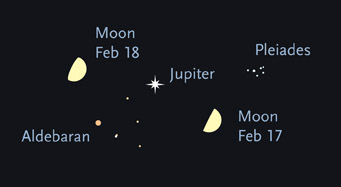The month begins with the Moon nowhere in sight, at least in the evening. But almost immediately after sundown you’ll see a starlike beacon far above the southern horizon — so high up that it’s almost overhead. That’s the planet Jupiter.

A waxing Moon is situated near brilliant Jupiter for two nights during February 2013.
Sky & Telesope diagram
A little to Jupiter’s right is a small cluster of stars called the Pleiades (or, sometimes, the Seven Sisters). These stars all formed together about 100 million years ago. Just a bit to Jupiter’s left is the bright star Aldebaran, marking the angry eye of Taurus, the Bull.
Another bright planet, Mercury, is viewable around the middle of February. Search for it beginning about the 9th or 10th low in the west as twilight darkens. Watch where the Sun sets, and then look just above that spot about 45 minutes later.
Well up in the east, look for Orion's distinctive belt, a trio of stars that make a diagonal row. To the belt’s upper left is Betelgeuse, and to the lower right is the blue-white diamond called Rigel.
February might be cold where you live, but its evenings offer many amazing sky sights. To track them down, download this month's 7½-minute-long audio sky tour.
 0
0
Comments
You must be logged in to post a comment.